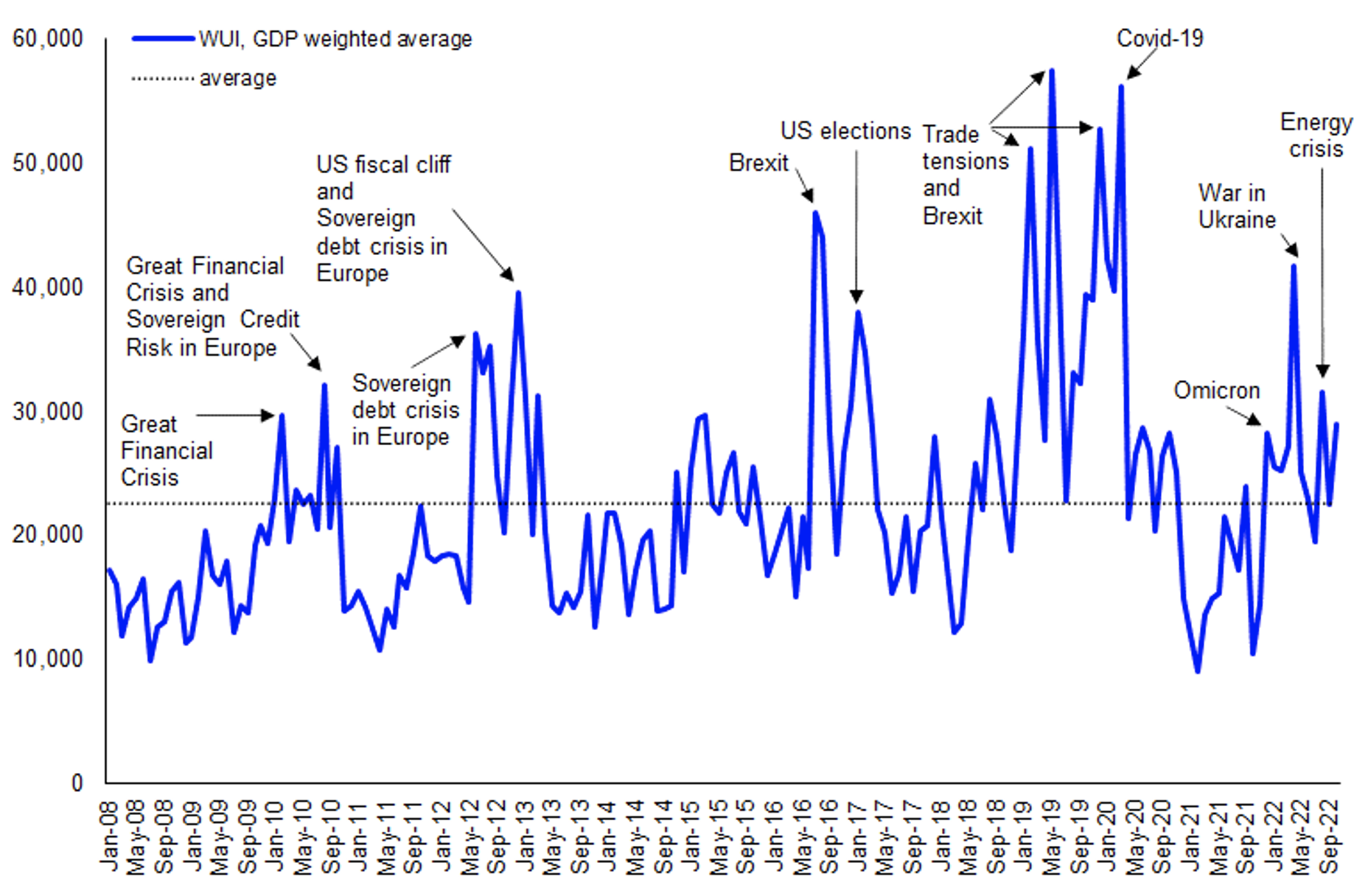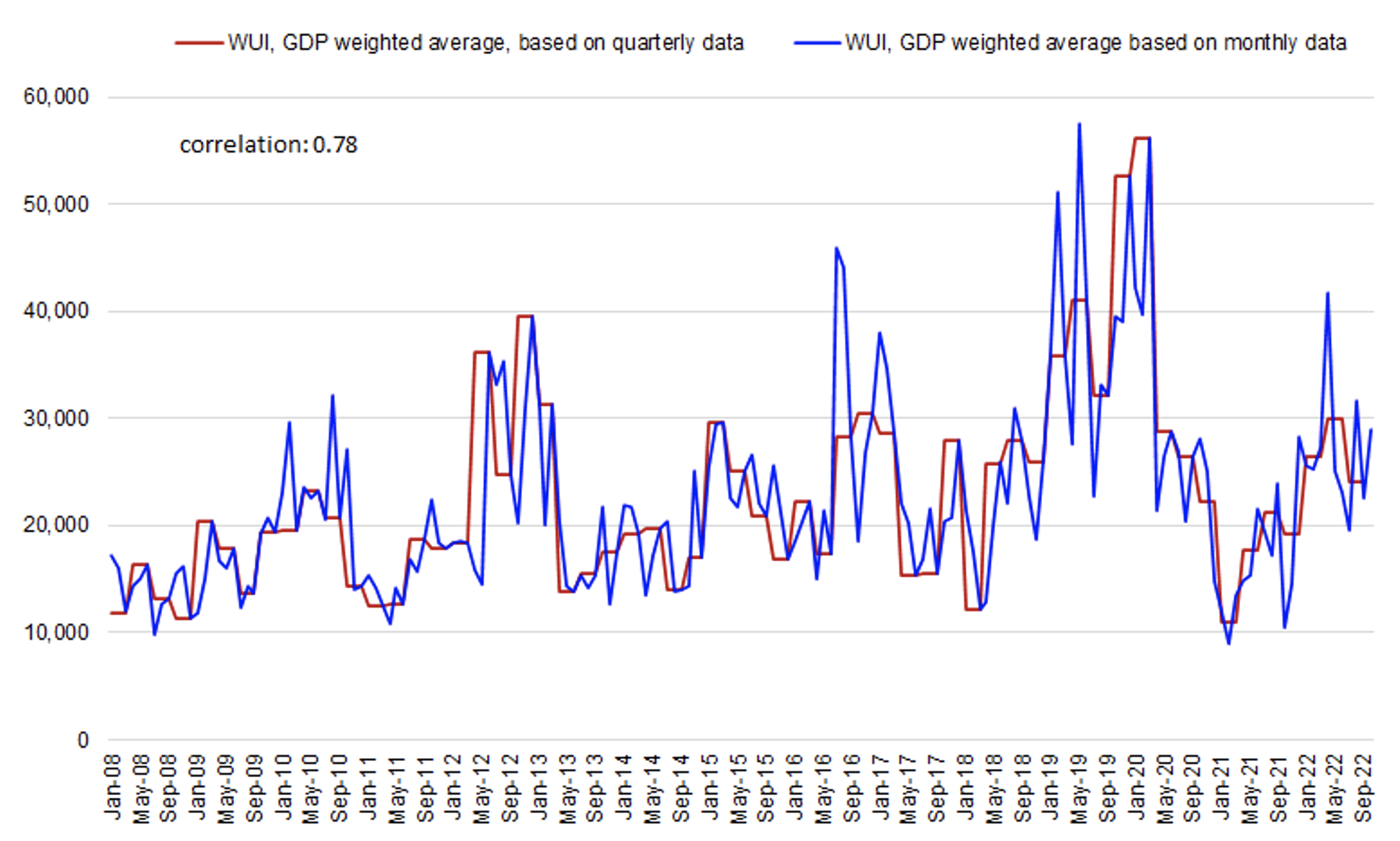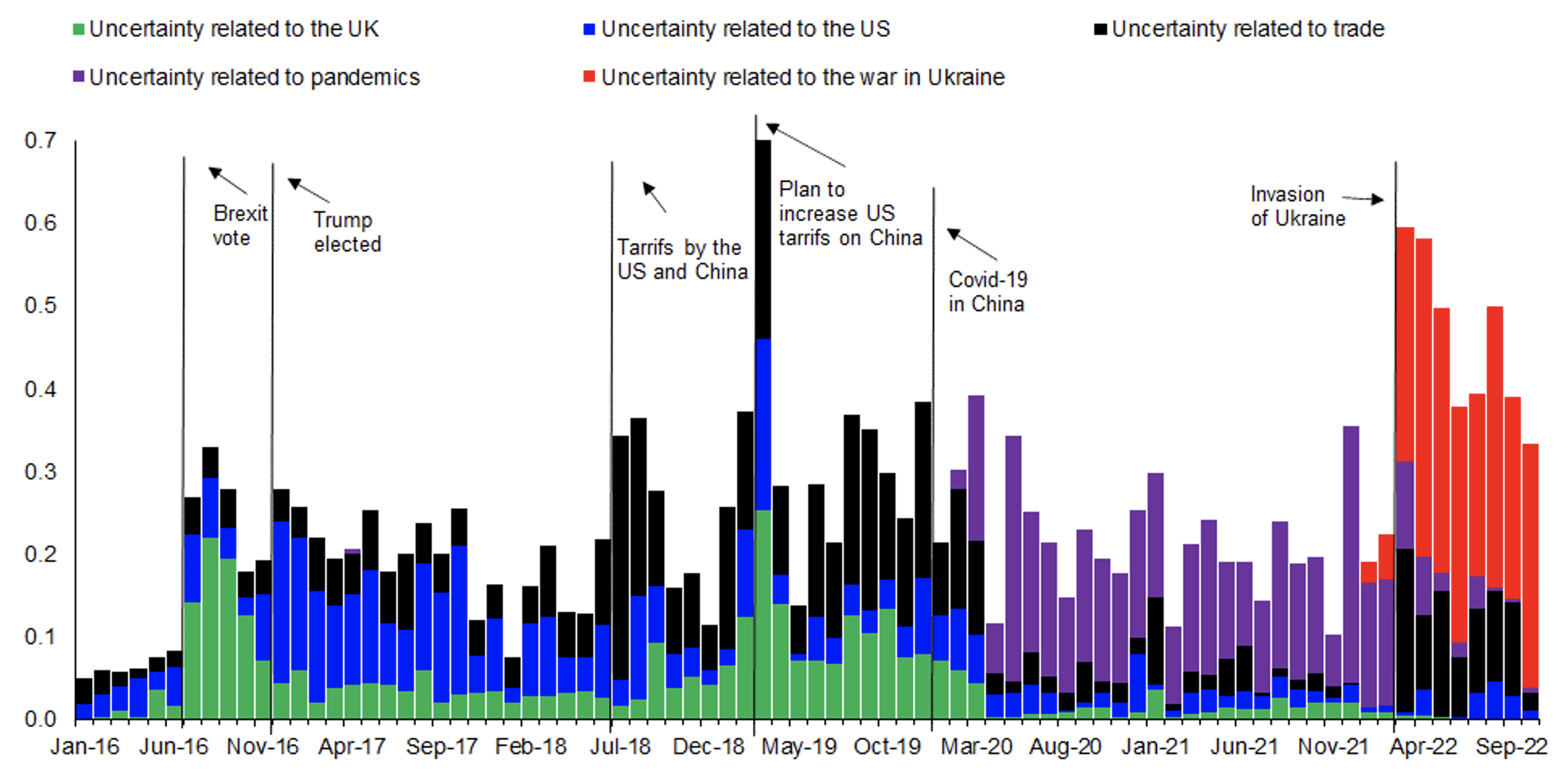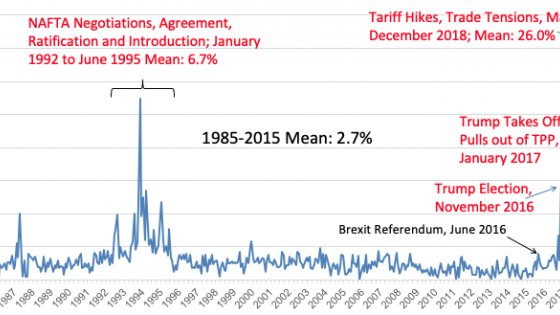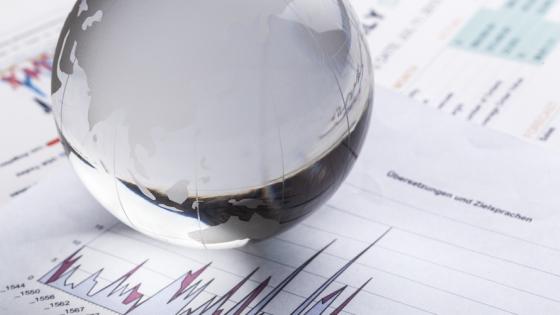In the past few years, the global economy has been hit by shock, after shock, after shock. These shocks include the trade tensions between US and China during 2018-2019, the Covid-19 pandemic, Russia’s invasion of Ukraine, the increase in inflation, and the rapid tightening of monetary policy. A common theme of these shocks, and a key characteristic of the current economic outlook (IMF 2022), is the associated economic and policy uncertainty.
In this context, policymakers and researchers across the globe need to track uncertainty in a timely manner. This implies having a measure of overall uncertainty in real time for different sources of economic and policy uncertainty. However, measures of economic uncertainty derived from statistical models are not well-suited to quickly capture shifts associated with sudden, surprise developments (e.g. Smietanka et al. 2020) as well as to disentangle types of uncertainty.
To obviate this, the literature on measuring uncertainty has made tremendous progress by relying on text-based measures of uncertainty. These measures of uncertainty are forward-looking in that they reflect the real-time uncertainty perceived and expressed by journalists, economists, and commentators when they discuss the economic outlook. Example of these measures are the Economic and Policy Uncertainty index (Baker et al. 2016), the Geopolitical Risk Index (Caldara and Iacoviello 2022), the Twitter measure of uncertainty (Baker et al. 2021), Search measure (Bontempi et al. 2021), and the World Uncertainty Index (WUI) available for 143 countries at a quarterly frequency (Ahir et al. 2018, 2022). We contribute to this growing literature by constructing a new monthly index of uncertainty for 71 countries using the Economist Intelligence Unit (EIU) country reports. To the best of our knowledge, this is the first effort to construct a text-based monthly measure of uncertainty covering a large set of developing countries and being comparable across countries.
A monthly version of the World Uncertainty Index
We extend our previous work to construct a new monthly version of the World Uncertainty Index (WUI) for 71 individual countries from 2008 onwards. The WUI is defined using the frequency of the word 'uncertainty' (and its variants) in the monthly Economist Intelligence Unit country reports. To make the WUI comparable across countries, the raw count is scaled by the total number of words in each report.
In contrast to existing measure of economic policy uncertainty, two factors help improve the comparability of the WUI across countries. First: the WUI is based on a single source. This source has specific topic coverage – economic and political developments. Second, the Economist Intelligence Unit reports follow a standardised process and structure. The process through which the Economist Intelligence Unit country reports are produced helps to mitigate concerns about the accuracy, ideological bias, and consistency of the WUI. But we only have one Economist Intelligence Unit report per country per month, meaning there is potentially quite large sampling noise.
Figure 1 shows the monthly version of the World Uncertainty Index from January 2008 to October 2022. It shows that global uncertainty has been constantly high since the 2016 Brexit vote. It reached historically high values in September 2019 with the US-China trade tensions and in March 2020 with Covid-19 spreading across the globe. After declining to levels below the historical average in 2021, it has resurged with the Russian invasion of Ukraine and the associated cost-of-living crisis.
Figure 1 Global World Uncertainty Index, January 2008 to October 2022 (GDP weighted average)
Source: Ahir et al. (2022)
How does it compare to the quarterly version?
Our new monthly version of the World Uncertainty Index builds on our previous quarterly version of the World Uncertainty Index (Ahir et al. 2022). There are three main differences between the two versions. First—frequency: one is monthly, while the other is quarterly. Second—time: the monthly version starts in 2008, while the quarterly version starts in the 1950s. And third—country coverage: the monthly version has data for 71 countries, while the quarterly version has data for 143 countries. These three differences are due to the fact that the Economist Intelligence Unit started to publish full country reports for 71 countries from January 2008 on a monthly basis.
Figure 2 compares the monthly versus the quarterly version of the World Uncertainty Index. The blue line shows the monthly version of the World Uncertainty Index. And the red line shows the quarterly version of the World Uncertainty Index for the same set of countries used in the monthly version (71 countries). For comparison, we set the quarterly WUI to have the same value in each month of the respective quarter. The two series follows a very similar patterns and they are highly correlated (the correlation is 0.8). At the same time, the monthly measures seem to better capture the increase in uncertainty during the Global Crisis, sovereign credit risk in Europe, Brexit, US elections, trade tensions, and the recent war in Ukraine.
Figure 2 World Uncertainty Index, January 2008 to October 2022 (GDP weighted average)
Source: Ahir et al. (2022)
Decomposition of overall uncertainty
One advantage of our text-based approach to measuring uncertainty is that we can break out the drivers of uncertainty, by analysing which words appear alongside mentions of uncertainty in our dataset. We have done the decomposition of overall uncertainty for trade, pandemic, spillovers from key systemic economies (such as the US, other G7 economies, and China), and the war in Ukraine. For instance, uncertainty spillovers from each of the systemic economies are measured by the frequency that the word ‘uncertainty’ is mentioned in the reports in proximity to a word related to the respective systemic-economy country. Specifically, for each country and month, we search the country reports for the words ‘uncertain’, ‘uncertainty’, and ‘uncertainties’ appearing near words related to each country. The country-specific words include the country’s name, name of presidents, name of the central bank, name of central bank governors, and the selected country’s major events (such as Brexit).
Figure 3 shows the contribution to overall uncertainty by five major shocks that have occurred since 2016. We see that in June 2016 uncertainty arising from the UK Brexit situation surged after the unexpected leave vote. This was overtaken by uncertainty arising from the US after its presidential election. In 2018, the China-US trade tensions began to cause major uncertainty for countries globally, becoming the biggest single driver. In 2020, the Covid-19 pandemic surged as a key driver of global uncertainty, only dropping back recently to be overtaken by uncertainty arising from the war in Ukraine and the renewed trade uncertainty associated with sanctions to Russia.
Figure 3 Contribution to overall uncertainty by five major shocks, January 2016 to October 2022
Source: Ahir et al. (2022)
Note: Below is the list of keywords included in each category for figure 3: (1) Uncertainty related to the United Kingdom: Andrew Bailey, Bank of England, Boris Johnson, Brexit, Britain, David Cameron, Edward George, Gordon Brown, John Major, Mark Carney, Mervin King, Theresa May, Tony Blair, and the United Kingdom. (2) Uncertainty related to the United States: Alan Greenspan, America, Barack Obama, Ben Bernanke, Bill Clinton, Donald Trump, Federal Reserve, George H. W. Bush, George W. Bush, Janet Yellen, Jerome Powell, Joe Biden, NAFTA, North America, and the United States. (3) Uncertainty related to trade: exports, imports, sanctions, protectionism, North American Free Trade Agreement, tariff, trade, United Nations Conference on Trade and Development, and World Trade Organization. (4) Uncertainty related to pandemics: Severe Acute Respiratory Syndrome, SARS, Avian flu, H5N1, Swine flu, H1N1, Middle East respiratory syndrome, MERS, Bird fu, Ebola, Coronavirus, Covid, Covid-19, Influenza, H1V1, World Health Organisation, pandemic, vaccine, omicron, delta, pathogen, and variant. (5) Uncertainty related to the war in Ukraine: Russia, Ukraine, sanctions, embargo, war, invasion, conflict, defense spending, military, geopolitical, Putin, Zelenskyy, oil, commodity, energy, and gas.
References
Ahir, H, N Bloom and D Furceri (2022), “World Uncertainty Index”, NBER Working Paper.
Ahir, H, N Bloom and D Furceri (2018), “Global uncertainty is rising, and that is a bad omen for growth”, VoxEU.org, 29 November.
Baker, S R, N Bloom and S J David (2016), “Measuring Economic Policy Uncertainty”, The Quarterly Journal of Economics 131(4): 1593-1636.
Baker, S, N Bloom, S Davis and T Renault (2021), “Twitter-Derived Measures of Economic Uncertainty”, mimeo.
Baker, S, N Bloom and S Davis (2011), “Policy uncertainty and the stalled recovery”, VoxEU.org, 22 October.
Bontempi, M, M Frigeri, R Golinelli and M Squardrani (2021), “EURQ: A New Web Search-based Uncertainty Index”, Economica 88(352): 969-1015.
Caldara, D and M Iacoviello (2022), “Measuring Geopolitical Risk”, American Economic Review 112(4): 1194-1225.
International Monetary Fund (2022), World Economic Outlook: Countering the Cost-of-Living Crisis, October, Washington.
Smietanka, P, G Thwaites, N Parker, T Renault, E Mihaylov, P Mizen, J Leather, B Meyer, S Chen, S Davis, P Bunn, N Bloom, J Barrero, S Baker and D Altig (2020), “Economic uncertainty in the wake of the COVID-19 pandemic”, VoxEU.org, 24 July.




